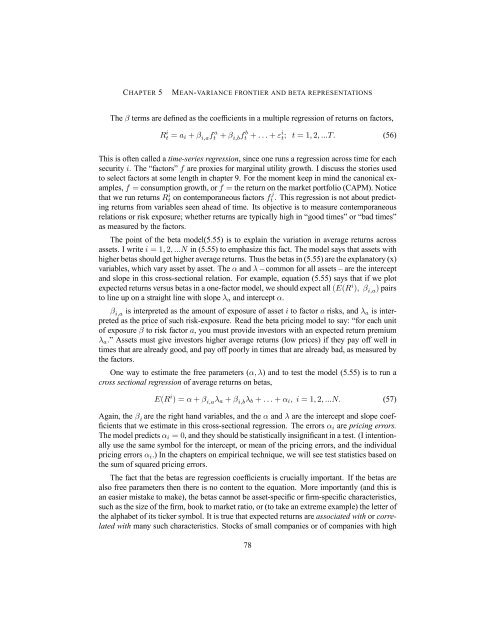Asset Pricing John H. Cochrane June 12, 2000
Asset Pricing John H. Cochrane June 12, 2000
Asset Pricing John H. Cochrane June 12, 2000
You also want an ePaper? Increase the reach of your titles
YUMPU automatically turns print PDFs into web optimized ePapers that Google loves.
CHAPTER 5 MEAN-VARIANCE FRONTIER AND BETA REPRESENTATIONS<br />
The β terms are defined as the coefficients in a multiple regression of returns on factors,<br />
R i t = ai + β i,af a t + β i,bf b t + ...+ ε i t; t =1, 2, ...T. (56)<br />
This is often called a time-series regression, since one runs a regression across time for each<br />
security i. The “factors” f are proxies for marginal utility growth. I discuss the stories used<br />
to select factors at some length in chapter 9. For the moment keep in mind the canonical ex-<br />
amples, f = consumption growth, or f = the return on the market portfolio (CAPM). Notice<br />
that we run returns R i t on contemporaneous factors f j<br />
t . This regression is not about predicting<br />
returns from variables seen ahead of time. Its objective is to measure contemporaneous<br />
relations or risk exposure; whether returns are typically high in “good times” or “bad times”<br />
as measured by the factors.<br />
The point of the beta model(5.55) is to explain the variation in average returns across<br />
assets. I write i =1, 2, ...N in (5.55) to emphasize this fact. The model says that assets with<br />
higher betas should get higher average returns. Thus the betas in (5.55) are the explanatory (x)<br />
variables, which vary asset by asset. The α and λ – common for all assets – are the intercept<br />
and slope in this cross-sectional relation. For example, equation (5.55) says that if we plot<br />
expected returns versus betas in a one-factor model, we should expect all (E(Ri ), βi,a) pairs<br />
to line up on a straight line with slope λa and intercept α.<br />
βi,a is interpreted as the amount of exposure of asset i to factor a risks, and λa is interpreted<br />
as the price of such risk-exposure. Read the beta pricing model to say: “for each unit<br />
of exposure β to risk factor a, you must provide investors with an expected return premium<br />
λa.” <strong>Asset</strong>s must give investors higher average returns (low prices) if they pay off well in<br />
times that are already good, and pay off poorly in times that are already bad, as measured by<br />
the factors.<br />
One way to estimate the free parameters (α, λ) and to test the model (5.55) is to run a<br />
cross sectional regression of average returns on betas,<br />
E(R i )=α + β i,aλa + β i,bλb + ...+ αi, i=1, 2, ...N. (57)<br />
Again, the βi are the right hand variables, and the α and λ are the intercept and slope coefficients<br />
that we estimate in this cross-sectional regression. The errors αi are pricing errors.<br />
The model predicts αi =0, and they should be statistically insignificant in a test. (I intentionally<br />
use the same symbol for the intercept, or mean of the pricing errors, and the individual<br />
pricing errors αi.) In the chapters on empirical technique, we will see test statistics based on<br />
the sum of squared pricing errors.<br />
The fact that the betas are regression coefficients is crucially important. If the betas are<br />
also free parameters then there is no content to the equation. More importantly (and this is<br />
an easier mistake to make), the betas cannot be asset-specificorfirm-specific characteristics,<br />
such as the size of the firm, book to market ratio, or (to take an extreme example) the letter of<br />
the alphabet of its ticker symbol. It is true that expected returns are associated with or correlated<br />
with many such characteristics. Stocks of small companies or of companies with high<br />
78
















